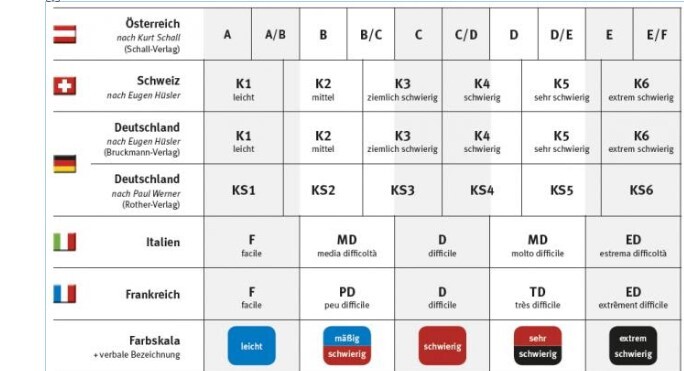Risks at Via Ferrata!
Choose the right level of difficulty for the via ferrata
Types of via ferrata and degrees of difficulty
Via ferratas can be found in all types of terrain. From the former Dolomite classics to the (often family-oriented) practice routes in many mountain valleys. Tourism offices and local governments are now often taking the initiative for new routes, often with easy accessibility and connecting to regular walking routes or close to cable cars and catering establishments. But it can also be a tough high mountain tour that requires crossing the glacier or 'Sport-klettersteig' that tends to physically challenging sport climbing, sometimes demanding the utmost technically and physically.
A Via Ferrata is classified according to approach, length, duration, number of altimeters, terrain, type, ... The information you find in tourist information, on the internet or in topo books, as well as orally, must always be interpreted in relation to your own knowledge and be able to. It goes without saying that a Via Ferrata can be easy for one person but extremely difficult for another, depending on one's own physical condition and technical baggage.
The difficulty of a via ferrata is influenced by a number of important factors that are included in the guide (also called topo) of that via ferrata, after which a general statement is made about the difficulty of that via ferrata. This general statement is usually abbreviated. Make sure you know what it stands for before starting a via ferrata.
The most commonly used are the alpine abbreviations in French.
Comparison: | |||
|---|---|---|---|
French | Schall | Hüsler | Description |
F | A | K1 | Easy (facile) |
PD | B | K2 (K3) | Little difficult (peu difficile) |
AD | C | K3 | Fairly difficult (assez difficile) |
D | C (D) | K4 | Difficult (difficulous) |
TD | D | K5 | Very difficult (très difficile) |
ED | E | K6 | Extremely difficult (extrèmement difficile) |
In Italian, TD becomes MOD and MD is a cross between PD and AD.
There are different difficulty notations in use, not only per country, but also because multiple scales are used. Here is a comparative table that gives a little more clarity:

Weather: respect for thunderstorms
When you climb to a mountain top along a Via Ferrata (or on a rock face lower in the valley), there are certain risks involved. Proper preparation can significantly limit these risks or make them manageable. Below are a number of risk factors that you should take into account:
The weather can change very quickly in the mountains. In the morning it can still be beautifully clear weather, which can quickly turn into rain and in the worst case thunderstorm in the afternoon.
The steel cables to which you secure yourself are an excellent conductor if lightning strikes them: so life-threatening. Make sure you are well informed in advance about the weather forecasts on site and also inquire just before you leave. This information is often also available in mountain huts. When a thunderstorm comes on faster, don't hesitate to turn around or choose an escape route…
Stone chips
A specific danger in the mountains is crushed stone. Because there are often climbers above you in the route, stone chips can be caused and you cannot jump too far away. A helmet is a must for safe climbing. Warn other climbers if stone chips occur by saying “Stein!” (Austria), “Caillou!” (France) or in Italy “Sasso!” to call. With such a warning, stay as close to the wall as possible and do not look up to check whether there are really stone chips!
Preparation
Make sure you are well prepared, both in terms of information and your own abilities and fitness ... and that of your fellow travelers! Consider carefully how difficult a certain route is and how long it will take you. Rather do something shorter and easier than immediately over galloping. Overestimation can be a big problem, it is no use to anyone if halfway through the route it turns out that it was too difficult or that you couldn't handle it conditionally... with a greater chance of falling as a result.
As with any trip in the mountains, taking along a rescue blanket, first aid kit and a whistle is not an unnecessary luxury. Of course you also provide enough water and snacks.
Fall
Remember that a ViaFerrata set or absorber is made to reduce the risk of a fatal fall, but that doesn't mean you won't get hurt. You can best compare this with an airbag in the car... it's not because you have that that you want to crash, right?
CanyonZone Knowledge base Via Ferrata / Klettersteig: Go Back.
CanyonZone
-
- Experts in canyoning & caving gear - ship worldwide
-
- Rent outdoor equipment
- New items in assortment
- Special offers
- Pre-ordering 2025
- NEW - Petzl Canyoning / Caving Line 2025
- 2nd hand canyoning caving articles
- Items / packages customer specific
- Giftcards of CanyonZone
-
- Canyoning (basic) equipment
- Canyoning equipment packages
- Luggage / Travel Bags
-
Canyoning Neoprene clothing
- Size charts by Brand
- Aventure Verticale (AV) size charts
- CE4Y neoprene size charts
- GUARA neoprene size charts
- Seland neoprene clothing size charts
- Newex neoprene size charts
- NRS neoprene size charts
- Vade Retro neoprene size charts
- Custom made neoprene wetsuit, required size data
- Canyoning Wetsuits
- Protective Canyoning Clothing
- Canyoning Neoprene Headgear
- Canyoning Drysuit / Undersuit
- Canyoning Neoprene shirts & shorts
- Canyoning Knee - elbow protectors / pads
- Canyoning Neoprene gloves
- Canyoning Neoprene socks
- Canyoning shoes
- Harnesses & Accessories
- Helmets outdoor sports
- Carabiners & maillons
- Descend devices
- Ascending / Rise along rope
- Pulleys
- Rope & webbing slings
- Anchoring & accessories
- Via Ferrata / Klettersteig sets
- Outdoor Gloves / (ice-)canyoning, caving, via ferrata
- Canyoning Back Packs, bags & duffels
- Drybags & Kegs, Boats
- Outdoor Knives & Scissors
- Safety in outdoor sports
- First Aid / Medical Articles
- Rescue in outdoor sports
- Camping, Bivouac & Backpacking
- Winter- / Ice Canyoning
-
Canyoning Books & Topographic Maps
- Map Pouch
-
Canyoning Guide Books
- Australia
- Austria
- France (including Corsica and La Reunion)
- Germany
- Greece (including Crete) / Balkans
- Israel
- Italy (including Sardinia)
- Jordan / Middle East
- Morocco
- New Zealand & Australia
- Portugal (including Madeira and Azores)
- Scandinavia
- Slovenia
- Spain (including Canary Islands and Majorca)
- United Kingdom (UK) / Scotland
- United States of America
- South America
- Switzerland
- Turkey
- Canyoning Techniques & Skills
- Canyoning Maps
- Outdoor Children's Books
- Outdoor DVDs
- Via Ferrata / Klettersteig books
- Repair & Maintenance
- Miscellaneous items outdoor sports
-
- Especially for Ladies
- Especially for Children
- Especially for Instructors and Guides
- Especially for Outdoor Sports Companies
- Especially for Underwater / Cave diving / Diving
-
- Caving (basic) equipment
- Caving equipments packages
- Caving Suits / Overalls
- Caving Under Suits
- Caving Boots / Wellies
- Caving Socks
- Caving Knee- and Elbow Pads
- Caving Gloves
- Headlamps & torches
- Caving Bags & BackPacks
- Tents and Bivi bags
- Caving & Potholing Books
-
-
Climbing related gear: on request
-
- Services
-
- CanyonZone New(s)
- CanyonZone Customer Service
- Contact about Assortment
- Business ordering at CanyonZone
- About CanyonZone
- CanyonZone's FAQ
- CanyonZone's Knowledge Base
- About CanyonZone, owner Gertjan van Pelt
- Works together with
- Link exchange
-
- Privacy
- Terms and Conditions
-
Terms and Conditions Rental
-


